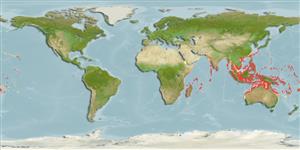>
Eupercaria/misc (Various families in series Eupercaria) >
Caesionidae (Fusiliers) > Caesioninae
Etymology: Caesio: Latin, caesius, bluish-grey, 1835; it is the same name given to the silvery metal (Cs) (Ref. 45335).
More on author: Seale.
Environment: milieu / climate zone / intervalo de profundidade / distribution range
Ecologia
marinhas associadas(os) a recifes; não migratória; intervalo de profundidade 5 - 60 m (Ref. 30874). Tropical; 30°N - 34°S, 28°E - 157°W (Ref. 402)
Indo-West Pacific: East Africa to the Line Islands. Not occurring in the Red Sea or the Arabian (Persian) Gulf.
Tamanho / Peso / Idade
Maturidade: Lm ? range ? - ? cm
Max length : 40.0 cm TL macho/indeterminado; (Ref. 11228); common length : 26.6 cm SL macho/indeterminado; (Ref. 37816)
Espinhos dorsais (total) : 10; Raios dorsais moles (total) : 14 - 16; Espinhos anais: 3; Raios anais moles: 12 - 13. This species is distinguished by the following characters: D X14-16, usually 15; A III,12-13, usually 12; pectoral-fin rays 18-23, usually 20-21; lateral line scales 51-61, usually 55; scales above lateral line to dorsal origin 7-10, modally 8, and below to anal-fin origin 16-20; predorsal scales 20-28; a single postmaxillary process; supratemporal band of scales interrupted at dorsal midline by a narrow scaleless zone; body colour blue with bright yellow on caudal fin, caudal peduncle, and body from just anterior to dorsal-fin origin to ventral origin of caudal peduncle, except in large individuals particularly in the western Pacific where the yellow does not extend as far anteriorly (Ref. 68703, 90102).
Body shape (shape guide): fusiform / normal; Cross section: compressed.
Adults are found primarily around coral reefs, with a preference for coralline lagoons. They feed on zooplankton in large midwater groups and form schools with other caesionids. Mature adults migrate to select areas around the reef to spawn near the surface in the entrances of deep channels during outgoing tides on a lunar cycle. They are oviparous, with numerous, small pelagic eggs (Ref. 402). Are caught with drive-in nets. Maximum depth reported taken from Ref. 128797.
Life cycle and mating behavior
Maturidade | Reprodução | Desova | Ovos | Fecundidade | Larvas
Mass spawning of this species observed to occur only around sunset at or near full moon.
Carpenter, K.E., 1987. Revision of the Indo-Pacific fish family Caesionidae (Lutjanoidea), with descriptions of five new species. Indo-Pac. Fish. (15):56 p. (Ref. 1723)
Categoria na Lista Vermelha da IUCN (Ref. 130435: Version 2025-1)
Ameaça para o homem
Harmless
Utilização humana
Pescarias: pouco comercial
Ferramentas
Relatórios especiais
Descarregue XML
Fontes da internet
Estimates based on models
Preferred temperature (Ref.
123201): 24.9 - 29.1, mean 28.2 °C (based on 988 cells).
Phylogenetic diversity index (Ref.
82804): PD
50 = 0.5010 [Uniqueness, from 0.5 = low to 2.0 = high].
Bayesian length-weight: a=0.01202 (0.00696 - 0.02076), b=3.10 (2.95 - 3.25), in cm total length, based on LWR estimates for this species & (Sub)family-body (Ref.
93245).
Nível Trófico (Ref.
69278): 3.4 ±0.45 se; based on food items.
Resiliência (Ref.
120179): Elevada, tempo mínimo de duplicação da população menor que 15 meses (Preliminary K or Fecundity.).
Fishing Vulnerability (Ref.
59153): Low to moderate vulnerability (30 of 100).
🛈
Nutrients (Ref.
124155): Calcium = 53.2 [35.4, 76.6] mg/100g; Iron = 0.708 [0.466, 1.023] mg/100g; Protein = 19 [18, 20] %; Omega3 = 0.138 [0.096, 0.196] g/100g; Selenium = 33.1 [21.1, 55.5] μg/100g; VitaminA = 99.1 [41.3, 244.0] μg/100g; Zinc = 1.1 [0.8, 1.5] mg/100g (wet weight);
